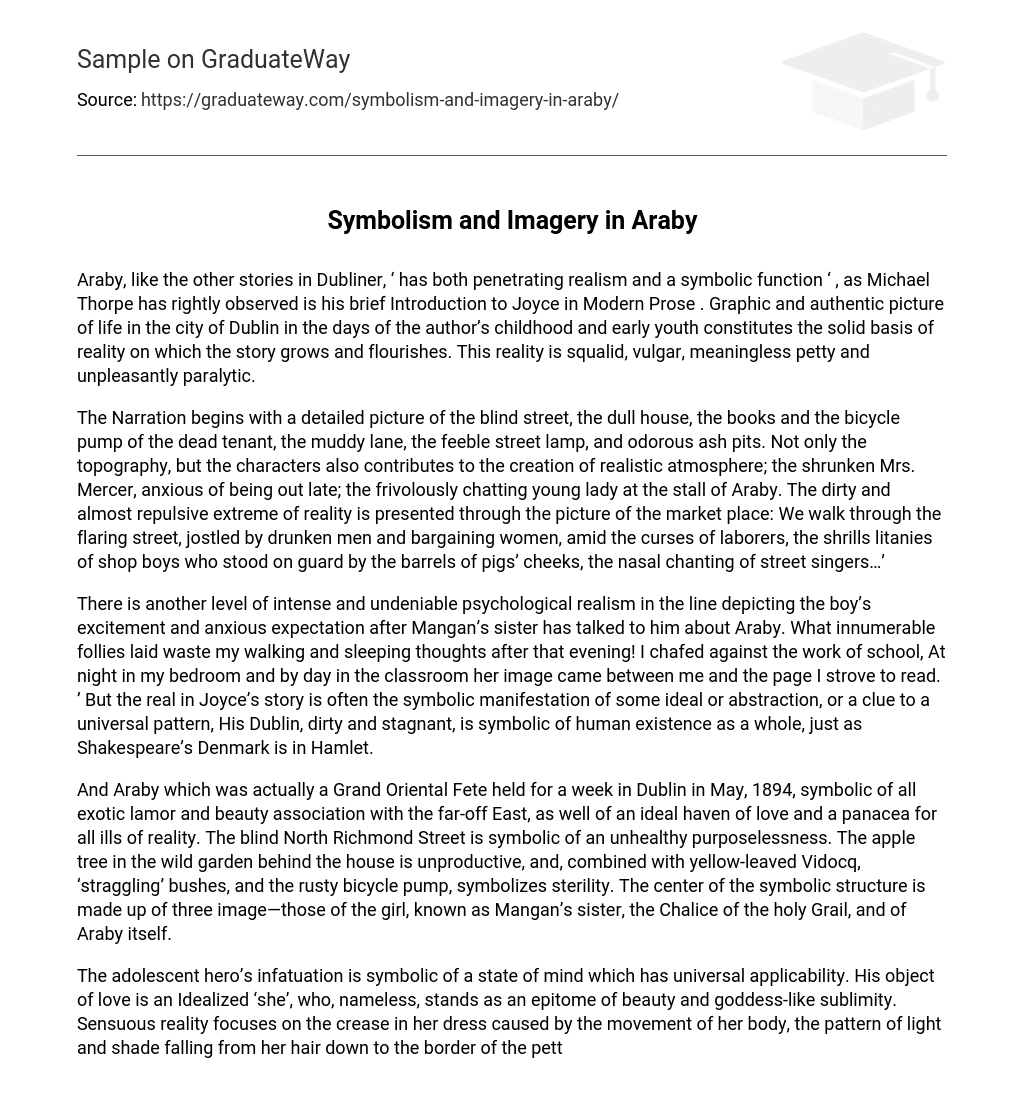Araby, like the other stories in Dubliner, ‘ has both penetrating realism and a symbolic function ‘ , as Michael Thorpe has rightly observed is his brief Introduction to Joyce in Modern Prose . Graphic and authentic picture of life in the city of Dublin in the days of the author’s childhood and early youth constitutes the solid basis of reality on which the story grows and flourishes. This reality is squalid, vulgar, meaningless petty and unpleasantly paralytic.
The Narration begins with a detailed picture of the blind street, the dull house, the books and the bicycle pump of the dead tenant, the muddy lane, the feeble street lamp, and odorous ash pits. Not only the topography, but the characters also contributes to the creation of realistic atmosphere; the shrunken Mrs. Mercer, anxious of being out late; the frivolously chatting young lady at the stall of Araby. The dirty and almost repulsive extreme of reality is presented through the picture of the market place: We walk through the flaring street, jostled by drunken men and bargaining women, amid the curses of laborers, the shrills litanies of shop boys who stood on guard by the barrels of pigs’ cheeks, the nasal chanting of street singers…’
There is another level of intense and undeniable psychological realism in the line depicting the boy’s excitement and anxious expectation after Mangan’s sister has talked to him about Araby. What innumerable follies laid waste my walking and sleeping thoughts after that evening! I chafed against the work of school, At night in my bedroom and by day in the classroom her image came between me and the page I strove to read. ’ But the real in Joyce’s story is often the symbolic manifestation of some ideal or abstraction, or a clue to a universal pattern, His Dublin, dirty and stagnant, is symbolic of human existence as a whole, just as Shakespeare’s Denmark is in Hamlet.
And Araby which was actually a Grand Oriental Fete held for a week in Dublin in May, 1894, symbolic of all exotic lamor and beauty association with the far-off East, as well of an ideal haven of love and a panacea for all ills of reality. The blind North Richmond Street is symbolic of an unhealthy purposelessness. The apple tree in the wild garden behind the house is unproductive, and, combined with yellow-leaved Vidocq, ‘straggling’ bushes, and the rusty bicycle pump, symbolizes sterility. The center of the symbolic structure is made up of three image—those of the girl, known as Mangan’s sister, the Chalice of the holy Grail, and of Araby itself.
The adolescent hero’s infatuation is symbolic of a state of mind which has universal applicability. His object of love is an Idealized ‘she’, who, nameless, stands as an epitome of beauty and goddess-like sublimity. Sensuous reality focuses on the crease in her dress caused by the movement of her body, the pattern of light and shade falling from her hair down to the border of the petticoat. But it is only illusion of reality, and has no clue of the mystic identity of the eternal female.
The admitted feeling of ‘confused adoration’ on the part of the boy brings in an unmistakable religious association, which is re-enforced with the symbolic image of the legendary Grail: ‘I bore my chalice safely through a throng of foes’. The tense lonely journey of the boy towards Araby thus become a pilgrimage, and symbolizes a quest of the mysterious ultimate means of salvation. The very loneliness is symbolic of the loneliness of each individual soul, and the delay is the inevitable feeling of endless waiting for the most coveted thing in life. Real Araby itself breaks the illusion of idealism the boy had attached to it.
Instead of the soul-charming music casting ‘an Eastern enchantment’ which he could hear by simply uttering the syllables of the word ‘Araby’, he now hears a totally opposed and debased sort of music: ‘… two men were counting money on a salver. I listened to the fall of the coin. ’ The special dimension and character of the story depends much on this transference of associated thoughts from the symbolic world of lofty refinement to the contrasted fallen word of reality. An equivalent of sacred chalice or grail which the boy seek in Araby to serve as a gift appropriately signifying his ove and adoration, is pitted against porcelain vases and flowered tea-set of cheap utilitarian connotation. He feels himself an alien in this world, unable to communicate in its term. The great jars, standing on two sides of the entrance of the stall ‘like eastern guard’, are symbolic of prohibition and intimidation. The refinement and sublimity the speaker expected in the ambience of the very special fete in his imagination might be pursued with some hope in the elevation of the ‘upper part of the hall’. But putting off of the light brings about complete darkness there, an unmistakable symbol of defeat and utter failure.
Yet, id darkness symbolizes, frustration and end of road, fire may legitimately signify hope of a new beginning. It is not meek resignation that the burning eyes of the protagonist symbolize rather they are evocative of the image of fire in which the mythical Phoenix burns itself to emerge anew out of the very ashes. The whole texture of the story is thus uniquely sustained pattern on the twin-color of realism and symbolism. In fact not a single paragraph in the story is mere factual reporting, but enriched in a symbolic overtone.





